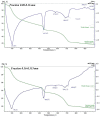Demolition Waste Potential for Completely Cement-Free Binders
- PMID: 36079400
- PMCID: PMC9457524
- DOI: 10.3390/ma15176018
Demolition Waste Potential for Completely Cement-Free Binders
Abstract
Due to renovation and fighting in the world, a huge accumulation of construction and demolition waste is formed. These materials are effectively used as aggregates, but there is very little information about the use of scrap concrete to create cementless binders. The purpose of the work is to be a comprehensive study of the composition and properties of concrete wastes of various fractions with the aim of their rational use as cementless binders. The scientific novelty lies in the fact that the nature of the processes of structure formation of a cementless binder based on sandy fractions of the screening of fragments of destroyed buildings and structures, as a complex polyfunctional system, has been theoretically substantiated and experimentally confirmed. Different percentages of non-hydrated clinker minerals in concrete scrap were determined. In the smallest fraction (less than 0.16 mm), more than 20% of alite and belite are present. Waste of the old cement paste is more susceptible to crushing compared to the large aggregate embedded in it, therefore, particles of the old cement paste and fine aggregate predominate in the finer fractions of the waste. Comprehensive microstructural studies have been carried out on the possibility of using concrete scrap as a completely cementless binder using scanning electron microscopy, X-ray diffraction analysis, and differential thermal analysis. It has been established that for cementless samples prepared from the smallest fractions (less than 0.315 mm), the compressive strength is 1.5-2 times higher than for samples from larger fractions. This is due to the increased content of clinker minerals in their composition. The compressive strength of the cementless binder after 28 days (7.8 MPa), as well as the early compressive strength at the age of 1 day after steaming (5.9 MPa), make it possible to effectively use these materials for enclosing building structures.
Keywords: cement-free binders; clinker minerals; concrete waste; microstructural studies.
Conflict of interest statement
The authors declare no conflict of interest.
Figures









Similar articles
-
Recycling of Cement Industry Waste for Alkali-Activated Materials Production.Materials (Basel). 2022 Sep 26;15(19):6660. doi: 10.3390/ma15196660. Materials (Basel). 2022. PMID: 36234004 Free PMC article.
-
Reusing Construction and Demolition Waste to Prepare Alkali-Activated Cement.Materials (Basel). 2022 May 10;15(10):3437. doi: 10.3390/ma15103437. Materials (Basel). 2022. PMID: 35629464 Free PMC article.
-
Utilization of Low-Grade Limestone and Solid Waste for the Preparation of High-Belite Portland Cement.Materials (Basel). 2025 Jun 4;18(11):2641. doi: 10.3390/ma18112641. Materials (Basel). 2025. PMID: 40508639 Free PMC article.
-
Recycling of ceramic tiles waste and marble waste in sustainable production of concrete: a review.Environ Sci Pollut Res Int. 2022 Mar;29(13):18311-18332. doi: 10.1007/s11356-021-18105-x. Epub 2022 Jan 11. Environ Sci Pollut Res Int. 2022. PMID: 35015234 Review.
-
Waste Glass in Cement and Geopolymer Concretes: A Review on Durability and Challenges.Polymers (Basel). 2021 Jun 24;13(13):2071. doi: 10.3390/polym13132071. Polymers (Basel). 2021. PMID: 34202421 Free PMC article. Review.
Cited by
-
Comparative study of eco-friendly wire mesh configurations to enhance sustainability in reinforced concrete structures.Sci Rep. 2024 Apr 17;14(1):8818. doi: 10.1038/s41598-024-59050-2. Sci Rep. 2024. PMID: 38627578 Free PMC article.
-
Volume Deformation and Hydration Behavior of Ordinary Portland Cement/Calcium Sulfoaluminate Cement Blends.Materials (Basel). 2023 Mar 27;16(7):2652. doi: 10.3390/ma16072652. Materials (Basel). 2023. PMID: 37048945 Free PMC article.
-
Influence of Pretreatment Methods on Compressive Performance Improvement and Failure Mechanism Analysis of Recycled Aggregate Concrete.Materials (Basel). 2023 May 18;16(10):3807. doi: 10.3390/ma16103807. Materials (Basel). 2023. PMID: 37241433 Free PMC article.
-
Mechanical Behavior of Crushed Waste Glass as Replacement of Aggregates.Materials (Basel). 2022 Nov 15;15(22):8093. doi: 10.3390/ma15228093. Materials (Basel). 2022. PMID: 36431578 Free PMC article.
-
Recyclable Materials for Ecofriendly Technology.Materials (Basel). 2022 Oct 13;15(20):7133. doi: 10.3390/ma15207133. Materials (Basel). 2022. PMID: 36295198 Free PMC article.
References
-
- Xiao R., Jiang X., Zhang M., Polaczyk P., Huang B. Analytical Investigation of Phase Assemblages of Alkali-Activated Materials in CaO-SiO2-Al2O3 Systems: The Management of Reaction Products and Designing of Precursors. Mater. Des. 2020;194:108975. doi: 10.1016/j.matdes.2020.108975. - DOI
-
- Manjunatha M., Seth D., Kvgd B., Bharath A. Engineering Properties and Environmental Impact Assessment of Green Concrete Prepared with PVC Waste Powder: A Step towards Sustainable Approach. Case Stud. Constr. Mater. 2022;17:e01404. doi: 10.1016/j.cscm.2022.e01404. - DOI
-
- Murthi P., Veda Sri N., Mudassir Baig M., Abdul Sajid M., Kaveri S. Development of Green Concrete Using Effective Utilization of Autoclaved Aerated Concrete Brick Trash as Lightweight Aggregate. Mater. Today Proc. 2022 doi: 10.1016/j.matpr.2022.07.316. - DOI
-
- Chen H., Chow C.L., Lau D. Developing Green and Sustainable Concrete in Integrating with Different Urban Wastes. J. Clean. Prod. 2022;368:133057. doi: 10.1016/j.jclepro.2022.133057. - DOI
-
- Pavlu T., Kocí V., Hájek P. Environmental Assessment of Two Use Cycles of Recycled Aggregate Concrete. Sustainability. 2019;11:6185. doi: 10.3390/su11216185. - DOI
LinkOut - more resources
Full Text Sources

